A busy time
It's the end of the 2018-19 chess league season and a natural time for a retrospective post.
It's been a busy year in my non-chess life. I've changed jobs. My daughter went from a few weeks to one year old (happy birthday gorgeous). My wife and I are trying to buy a house. I've committed to a fitness routine more successfully than any time in the last 10 years. Oh, and I've made a serious attempt to improve at chess! So between all those things I've not had too much time to write about my games for my avid online chess blog audience. But don't worry I haven't forgotten you.
So what happened this season in chess? The most striking feature of the year is I've not lost a single classical time control game! The season has been mostly wins with a sprinkling of draws. At first sight that statistic seems very impressive, but I took some embarrassing, ego bruising losses when I first started playing at the tail end of lasts season. So my initial grade (1161) at the start of the season was probably an under estimate of my true strength. Because of that very weak initial performance, I was put in a team in the 3rd division of the Leeds Chess Association league, where the best players are ranked only slightly higher ranked than me. So my high win rate should be seen in that light.
But that's not the whole story. I faced a few stronger opponents in non-league events where the wins and draws were much harder earned.
Half way through the season I got my first true ECF grade of 128. A nice bump upwards, at the season midpoint. And I'm expecting a similar bump for the next grading cycle too.
The season highlight
Unlike the LCA league, the Arjay tournament is between teams of any strength without division boundaries. In mid-February my team, Rose Forgrove D, found ourselves in the quarter finals of this tournament against Moortown A. The letters after the team names gives some indication of their relative strength. As the highest rated of our three-man team I was playing top board against their highest rated player, Peter Rooney. He has a rating of 192, close to master strength2 and by far the strongest rated person I've played over the board.
With three players per team, one team will have the white pieces on two boards, which is a slight advantage. To decide which team gets this edge, there's a coin toss. The top board of the toss-winning team gets one colour, the second and third boards get the other. We won the toss and, since I was so outgunned, I suggested to my captain that I take the black pieces and give the other two boards the white pieces. It was likely the game would be a loss anyway.
And so there's the set up. I had the black pieces against one of the best players in Leeds. And so, since I was so likely to lose, I decided to just have fun and could live with anything that wasn't a crushing defeat.
Opening
My opponent opened with the English 1. c4.
This is a less frequent, but not uncommon opening in which White fights for control of the centre from the flank.
I know that the best move here is to contest White's claim to the centre with 1... e5.
The position is then a reversed Sicilian defence, with Black down a tempo.
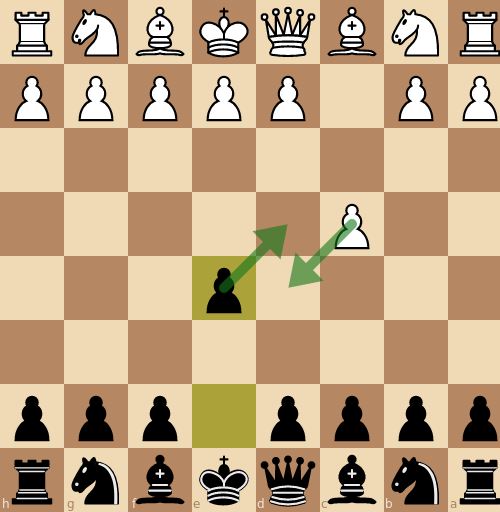
But I decided not to play that.
There's a funny psychological aspect to chess.
Since this is the best move, it's probably the response he sees the most from his best opponents.
At the time I was working my way through a book on the Slav defence, which is a response to Queen's gambit, 1.d4 d5 2.c4 c6.
So with this opening in mind, I tried to see if I could steer the game in that direction with 1... c6, hoping we would play 2. d4 d5 and transpose to a Slav.
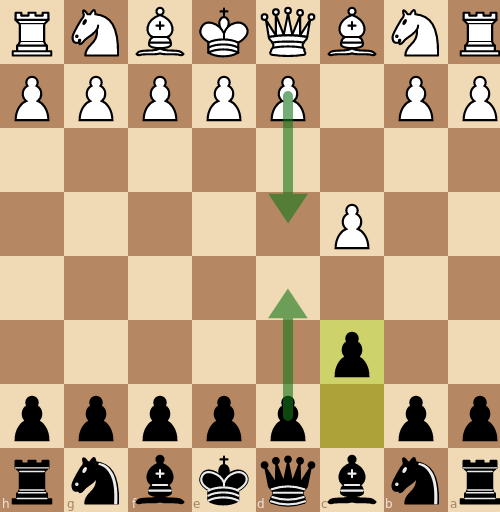
White did not oblige. And so I was out of opening preparation early against a 192 rated opponent… brilliant.
He played 2. Nf3, which is flexible, I decided to be flexible too and see what his plan was with 2... Nf6.
He played 3. g3 to fianchettoed his light square bishop to prepare quick castling.
So decided to try to get a grip on the centre with 3... d5.
As he proceeded I decided that, as in the Slav, I would get my light square bishop into the game before supporting my centre pawn with e6.
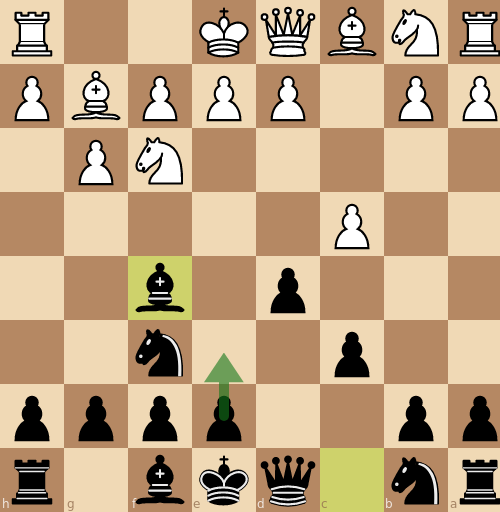
In Slav setups, Black has to take some care with his move order.
So I burned a fair chunk of time checking I wouldn't have problems with a quick Qb3 from White, attacking the now undefended b7 pawn.
But that didn't happen.
After this White castled and fianchettoed his dark square bishop.
I continued with some harmonious development, 5. O-O e6 6. b3 Nbd7 7. Bb2 Bd6.
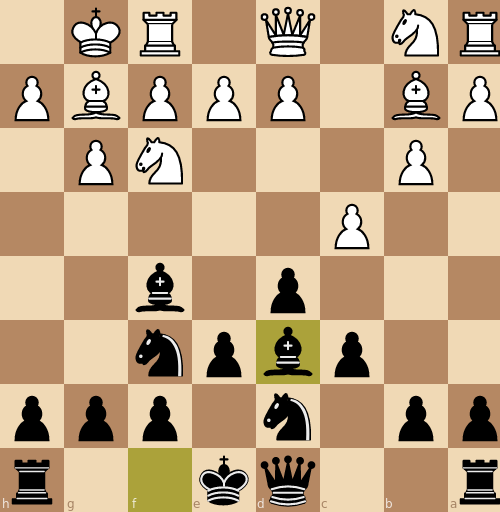
Returning to this game some months later with an expanded opening repertoire, I'm pleased to see my past self unknowingly adopted a reverse London System setup!
At this point White captured on d5 and I faced my real first choice: which way to recapture?

It's common in the London to recapture with the e-pawn, but I didn't know this at the time.
What I did know is that a common plan in the English is to move a rook to c1 and attack down the c-file.
So to play against that standard plan, I decided to play 8...exd5.
It was not without serious deliberation since I hadn't castled yet.
White managed to put some significant pressure on me with his next move.
Worrying about White's e4 break
White played 9.d3, and I have some things to worry about.
White is preparing 10. e4, with an attack on the bishop and the pawn.
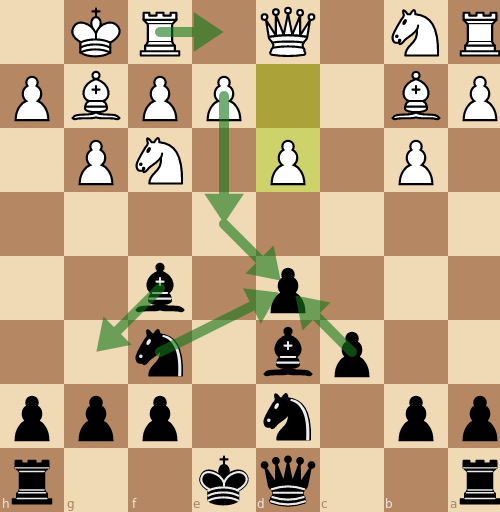
I would need move the bishop at which point, after 11. exd5 there's an open file to my king!
Therefore I need to preemptively move my bishop.
I spent a bit of time thinking here because there are longer term strategic considerations here.
I don't want White to open the position while I'm not castled, so I need to castle quickly after I move my bishop.
However I must react to 10. e4 since (if I just castle 10...O-O) there is 11. e5, which forks my knight and bishop.
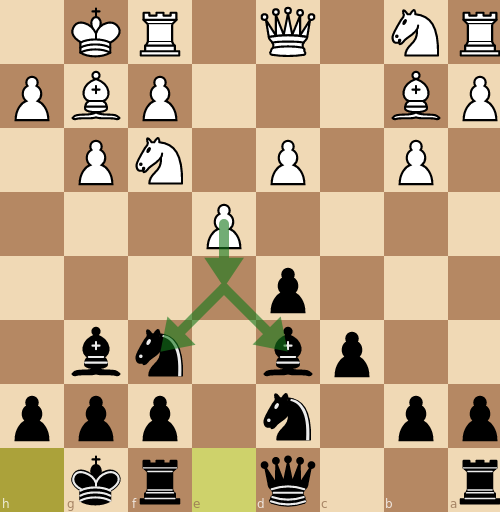
So taking his d4 pawn would be forced, and his recapture 11.dxe4 his queen is on my undefended bishop on d6 and the threat of pushing is pawn to e5 is still in the air.
And I'm still not castled!
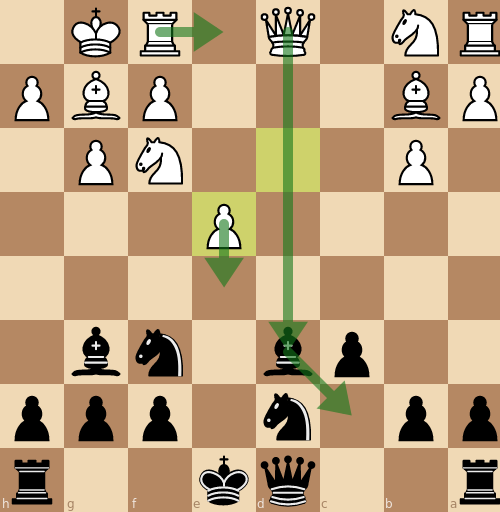
And to top it all off if we end up in that position, White's dark square bishop on b2 would be a monster.
And so after some thought I realised that a solution was to play Bg4.
This solves two of my problems.
Firstly, it means 10. e4 would not come with tempo on my bishop and also 11. e5 is not a threat since White's knight on f3 is pinned to his queen.
I could just take the pawn on e5 with my dark square bishop and challenge his monstrous bishop on b2.

I think this was White's plan based on his next move, 10. h3.
White wanted no part of that pin and wanted to force my bishop to a decision.
At this point I happily parted with my light square bishop 10... Bxf3 11. Bxf3 O-O.
There were two reasons to be happy:
- Having the bishop pair is a slight advantage in a wide open middle game, but I thought that controlling
e5was more important (and I had a plan to deal with the dark square bishop) - Having played
g3, also playingh3weakens the pawns around his king. I can't take advantage of this right now, but maybe later…

After this White played 12. Nd2, developing his last piece and reinforcing the e4 square while keeping his b2 bishop unblocked.
Time to deal with that b2 bishop!
I played 12... Be5 offering a trade of the bishops, White declined with 13. d4.
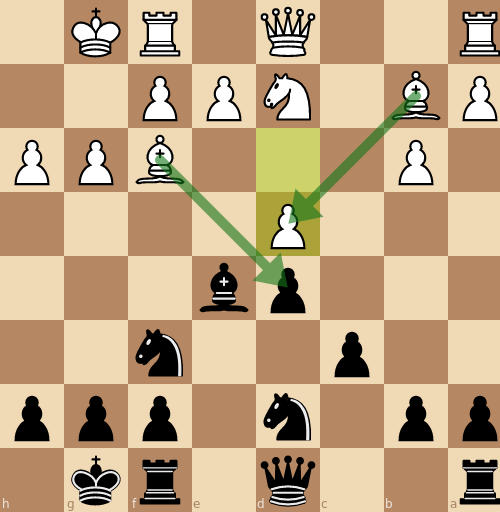
Analysing a chess game with a computer is a funny thing.
Through out all this the evaluation of the position is very close to equal.
But that's not how it felt to play.
I had all these concrete problems a few moves ago, but after White played d4 I felt like I had some breathing room.
His dark square bishop is now aimed at his own pawn, and his light square bishop is aimed at the head of my pawn chain.
To reactivate his dark square bishop he needs to push his d4 pawn to d5, a square which is occupied and well defended.
After 13... Bc7, playing the immediate 14. e4 to try vacate d5 wouldn't work.
e.g. 14. e4 dxe4 15. Nxe4 Nxe5 16. Bxe6 Nf6, with a knight ready to jump into d5 after the undefended bishop on e4 retreats.
His dark square bishop would still be hobbled by his own pawn.

So after 13. d4 Bc7 White developed his queen, 14. Qc7, controlling e4 with another piece.
So to counter this, I needed to be ready to remove one of the pieces controlling e4 so I played 14... Ba5.
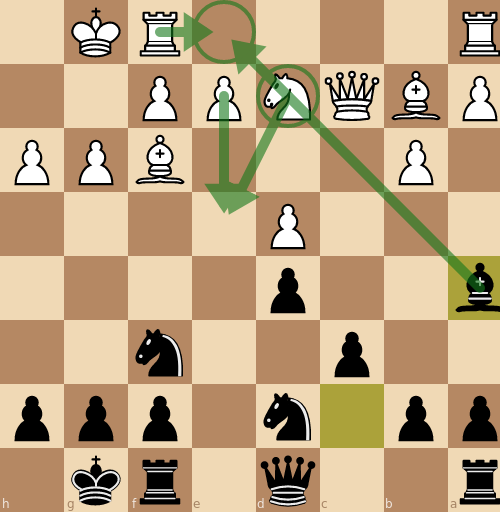
I was pleased with this move because I thought my bishop was being particularly pesky.
At the drop of a hat it can remove the knight on d2, one of the pieces controlling e4 but it also x-rays the e1 square.
White would like to add more pressure to e4 with Re1, but now it's a scary square to go to.
If the d2 knight moves, he loses the exchange.
This was the first point in the game I felt like I had posed a concrete problem for White to solve.
Show No Fear: Part 1
After the next two moves, I felt like I gained a slight initiative over White.
First, White played Rfd8 to overprotect his knight.
I suppose the logic of this is that if I capture with the bishop and he takes with the queen he loses two controllers of e4 in a single move.
(Suppose White plays a passing move like 15. h4) then 16... Bxd2 16. Qxd2 and I am the master of e4 with two controllers to his one.
I can continue to add defenders quickly too with moves like Re8.
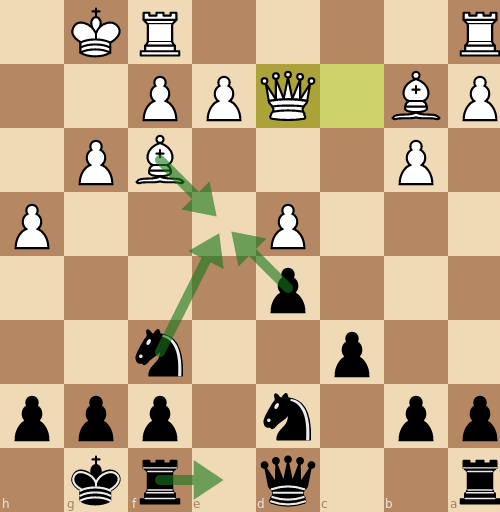
So, I continued to add pieces to the defence of e4 with 15... Re8.
At this point White played a weird move, 16. Nf1.

I didn't understand this move and now a few months later I still don't.
I suppose he was rerouting his knight somewhere?
To be fair his knight isn't much use on d2 as I'm getting my pieces to cover e4 more quickly than him.
It was an interesting psychological moment.
I didn't understand the move and he's a much higher rated player.
Had I just missed a good long term plan?
Whatever his reason, I now controlled e4 but was this what he wanted?
Since I decided I was probably going to lose anyway I decided to show no fear!
I jumped in with my knight, 16... Ne4, and we had some trades, 17. Bxe4 Rxe4.
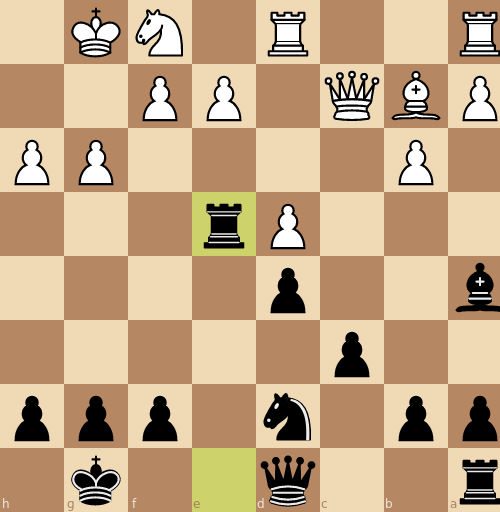
Now let's assess the position in the game.
White has some weak pawns around his king.
Fianchettoing his bishop to g2 early in the game weakens the h3 and f3 squares.
That's not a problem as long as the bishop remains around to watch over those squares, but now it's gone.
h3 is weak, with an undefended pawn on it.
Also, the only piece on White's king side is the knight on f1 and it doesn't seem to be doing anything useful.
I have a rook on the semi open e-file.
My pawn structure is solid on both wings and allows me to quickly activate my queen and a8 rook to bring them over to attack White's weak king side pawns.
I think I'm better here.
At this point White played a slow move, 18. a3, preparing to kick my bishop back with his queen side pawns.
However, the long term strategy of opening lines on the queen side could be a source of counter play.
This game the opportunity to go on the attack with 18... Qe7, aiming at his e2 pawn.

Because of my pesky bishop and his poorly placed knight, this can't be defended directly, so White pushed 19. e3.
I moved my knight closer to the king-side, 19... Nf6.
At this moment, White finally acknowledged that he won't be getting an e4 pawn break in.
He offered a trade of the dark square bishops, which I accepted 20. Bc3 Bxc3 21. Qxc3.
I continued to probe on the king side with 21... Qe7 22. Kg2.

A positional dance
What followed was a bit of a positional dance, in which I brought my pieces to the king side but struggled to find a way to break through.
I won't bore you with analysis, sufficed to say in this time White managed to untangle a bit and reactivate his knight.
22. Kg2 h5 23. Nd2 Re6 24. Nf3 Ne4 25. Qd3 Qe7 26. h4 Rf6 27. Rf1 Qe6 28. Ne5 Rf5 29. Ra2 29 Re8 30. b4
I still felt White was responding to my gentle pressure, although by untangling his pieces a bit, he did improve his position.
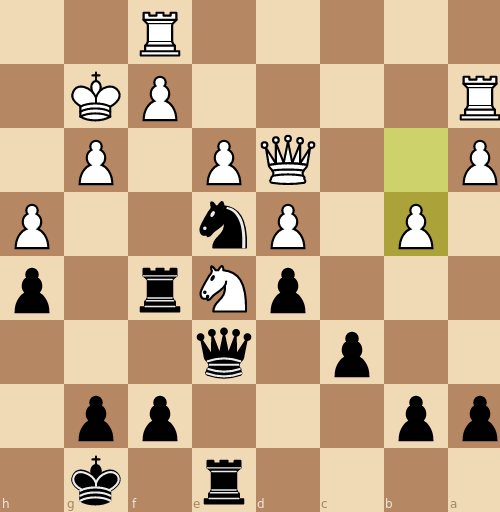
We resume the analysis at move 30. b4.
White started to roll his queen side pawns down the board for a minority attack, hoping to create some pawn weaknesses in my position and play against them.
I was still trying to pressure the weak squares around White's king, particularly the backwards f2 pawn with 30...Qf6.
(The computer thinks this was hopeless and marks a bunch of my moves around here as inaccuracies, including this one.)

I think White felt safe on the king side, with both his rooks and king defending f2 and moved his knight towards the queen side.
31. Nd7 with tempo, attacking my queen with the plan to go to c5, where it could challenge my beautiful knight on e4.
I would need to take time out to defend the pawn on b2 in which time he could initiate the trade on e5, removing my best king side attacker.
This much I had seen and had managed to lay a trap.
I played 31... Qd6 saving the queen and targeting the undefended knight on d7.
Given the nature of my trap, the computer says the best move is for him to just go back with 32. Ne5.
Instead, he went ahead with his plan of trying to force a knight trade with 32. Nc5.

Show No Fear: Part 2 – Attack!
I just wrote confidently of laying a trap, but it's worth noting the time situation at this stage of the game. I had 15 minutes left on the clock, my opponent had 30. A highly committal attacking move was possible, but I was sure that a player of my opponent's calibre would find an escape if I had missed anything. Should I spring the trap? Getting much lower on time against such a strong opponent was not a good idea in an approximately equal position. And since I was likely to lose anyway, and the time situation was only going to get worse, I decided to just go for it.
Can you see the move?
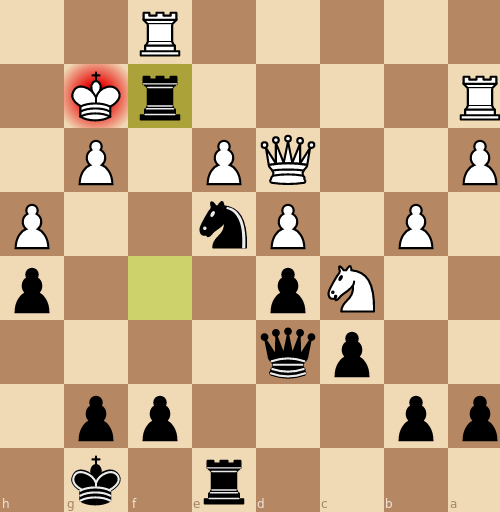
32... Rxf2+! A rook sacrifice on f2 with check! BANG!
Since it came with check, White had no time to take my knight on e5.
White had a choice of recaptures and chose (correctly) 33. Rfxf2.
Now the secondary purpose of my earlier move 31... Qd6 was revealed.

33... Qxg3+! Queen takes g3 also with check! DOUBLE BANG!
White has to run, 34. Kf1.
I decided to give an extra check to see where the king would go, 34... Qh3+, and there was just no good square for him.
If he tried to tuck in behind his rook with 34. Ke2 then 34... Nxf2 35. Kxf2 as he could only recapture with the king, leading to a brutal skewer, 35. Qh2+, picking up the rook.
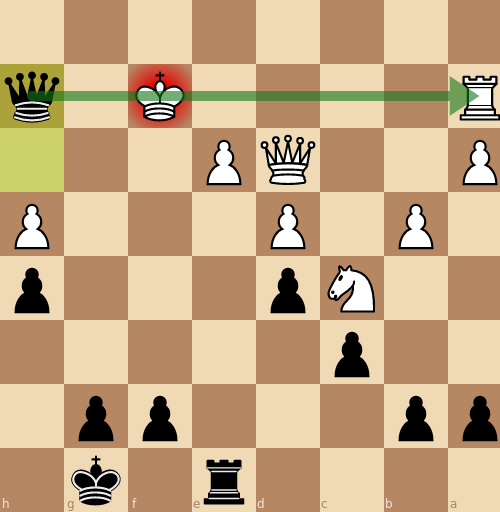
35. Ke1 is no good either, since 35... Nxf2 36. Rxf2 Rxe3+ losing the queen in a fork by my other rook.
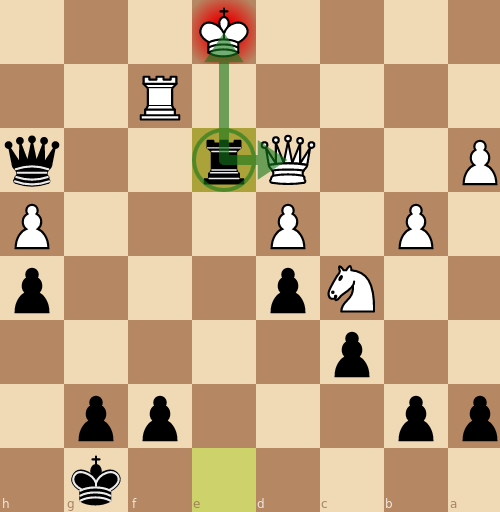
To avoid these lines White moved towards my queen.
We had 35. Kg1 Nxf2 36. Rxf2 Rxe3, winning back the exchange and attacking the queen.
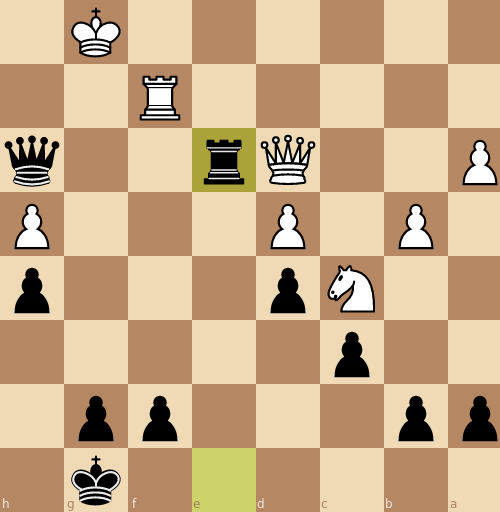
White was totally busted here.
If he avoided mate and trades off my attackers I can pick up his a3 pawn, probably his h4 pawn too.
He won't be stopping three king side passed pawns.
There are still some serious threats here and so White tried 37. Qf1 to challenge my queen.
Of course I have no intention of trading and so I played the calm 37... Qxh4.

Aside from the checks, black is also threatening to pick up d4 in addition to a3.
White made a reasonable attempt to bring his only other piece back to defend, 38. Nd3.
I played a lovely move, leaving the undefended pawn on d4 alone.
38... Rh3, and White can't defend h-file.
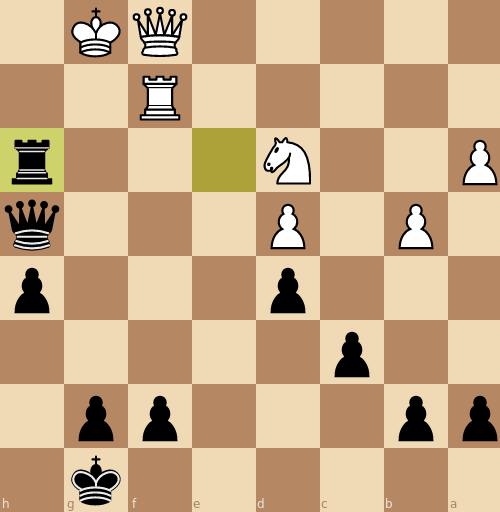
If I get my rook to h1 it's a mate in 2, for example 39. Nf1 40. Re1+ 41. Kg2 Qh3#.
In all other lines he must give up his queen for the rook, e.g. 39. Qxh3, 39. Qg2 Rg3.
At this point my opponent resigned.
Summary
I was on cloud nine for weeks after this game. Having such an exciting attack and converting it to win the game was exhilarating.
You can click through the game here.
I really enjoyed this season. Not because I was unbeaten (my streak will come to an end at some point soon I'm sure) but because I'm improving as a player. It's a long way up that rating ladder to become a chess master. But the occasional game like this makes me think it's not an impossible dream.
Footnotes:
The ECF uses a three digit rating system as opposed to FIDE and other well known chess bodies (e.g. USCF) which use a four digit system. The word over post-chess drinks is that you can get an approximate conversion from three-digit to four-digit with FIDE ≈ 7.5 × ECF + 700. Don't take this too seriously though, it's a very rough guide.
As I recently learned, defined as 2 consecutive seasons with a rating over 200 ECF.